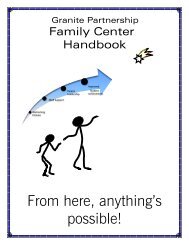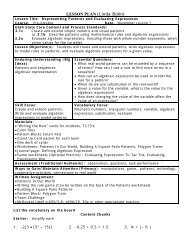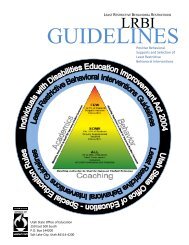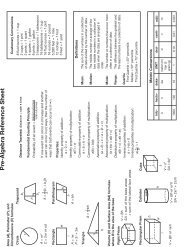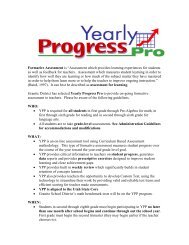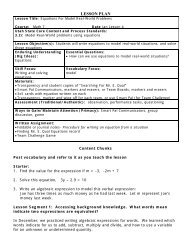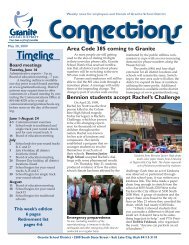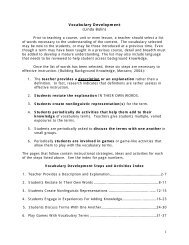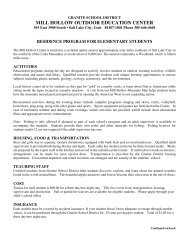LESSON PLAN (Linda Bolin) - Granite School District
LESSON PLAN (Linda Bolin) - Granite School District
LESSON PLAN (Linda Bolin) - Granite School District
Create successful ePaper yourself
Turn your PDF publications into a flip-book with our unique Google optimized e-Paper software.
<strong>LESSON</strong> <strong>PLAN</strong> (<strong>Linda</strong> <strong>Bolin</strong>)<br />
Lesson Title: The Distributive Property For Numerical and Variable Expressions<br />
Course: Pre-Algebra Date: Sept Lesson 2<br />
Utah State Core Content and Process Standards: 1.2c<br />
Recognize and use the distributive property of multiplication over addition<br />
Lesson Objective(s): Apply the distributive property in simplifying algebraic expressions<br />
Enduring Understanding (Big<br />
Ideas):<br />
Properties can be used to<br />
simplify mathematical<br />
expressions<br />
Skill Focus: Identify and use<br />
the distributive property<br />
Essential Questions:<br />
• How can I use the distributive property to multiply<br />
factors with two or more digits?<br />
• How can the distributive property be modeled using<br />
manipulatives?<br />
Vocabulary Focus:<br />
distributive property, factors, terms<br />
Materials:<br />
• Journal page: “Distributive Property Examples”<br />
• Algeblocks (units and x’s)<br />
• “Distributive Property With Algeblocks”<br />
Assessment (Traditional/Authentic): Performance tasks, observing<br />
Ways to Gain/Maintain Attention (Primacy): comparing, seeing patterns, manipulatives,<br />
story, sketching<br />
Written Assignment:<br />
• Journal page: “Distributive Property Examples” and examples from the Cookie Monster<br />
story<br />
• “The Distributive Property With Algeblocks” (worksheet)<br />
• p73/1-11; p74 # 38-39 (McDougall Littell Pre-Algebra)<br />
List the vocabulary on the board<br />
Content Chunks<br />
Starter: For each problem tell which way is easiest for you to do mentally.<br />
Explain why the one you chose was easier for you than the other.<br />
1. Which is easiest to do mentally for you?<br />
A. 2 • 50 + 2 • 9 OR 2 • 59<br />
B. 3 • 436 OR 3 • 400 + 3 • 30 + 3 • 6<br />
1 8<br />
C. x 9_ OR 9 x 10 + 9 x 8<br />
2. Use you calculator to do both problems for each above. Are the two<br />
expressions equivalent in each? What is the product?
Lesson Segment 1: How can I use the distributive property to multiply factors<br />
with one, two or more digits?<br />
Connect the problems in the Starter to the distributive property by asking them if 50 +<br />
9 is the same as 59, and if 400 + 30 + 6 is the same as 436, etc. Multiplying each of<br />
the place value parts of a number individually then adding the products together gives<br />
you the same answer as multiplying the entire number. The algorithm for<br />
multiplication is an example of how you have used the distributive property in your life.<br />
Use the journal page “Distributive Property Examples” to guide class and cooperative<br />
discussion in this manner:<br />
1. Look at one example and discuss the example making sure you USE THE<br />
VOCABULARY words in the last column.<br />
2. Have students work in pairs to try to place the words correctly in the blanks<br />
3. Have each pair share with another to see if they agree. Correct with whole class to<br />
make sure all words have been placed correctly in the blanks.<br />
4. Ask each pair to then make up an example and write it on their papers.<br />
5. Have each person share with another from another pair to explain why their<br />
example shows the use of the distributive property. If the partner doesn’t agree, they<br />
can work together to make corrections.<br />
Lesson Segment 2: How can the distributive property be modeled using<br />
manipulatives?<br />
Model and represent: Give each team a package of Algeblocks. Have them take out<br />
several green squares and several yellow bars. On the back of the journal have<br />
students sketch, and represent the models from “The Real Cookie Monster” as you go<br />
over the story with them. Ask one person to be the model builder, while a partner<br />
coaches. Both sketch the models and write the variable expression as you go through<br />
the story. Work with the students to represent each piece. The green represents<br />
exactly one cookie. The yellow bar is X and represents an undetermined number of<br />
cookies.<br />
Using the attached worksheet, “Distributive Property With Algeblocks”, as a guide, help<br />
students understand and apply the distributive property. Work together to complete #<br />
1-9. Have students take turns modeling as team members sketch and represent the<br />
questions.<br />
Lesson Segment 3: Practice<br />
Assign students to complete # 10-16 of the “Distributive Property With Algeblocks”<br />
worksheet. Go over any additional practice you select from a text book.
Distributive Property Examples Date______ Name__________________<br />
Example My own example My words<br />
1. 3(20 + 4) = 3 · 20 + 3 · 4<br />
3 (24) = 60 + 12<br />
72 = 72<br />
Use these words:<br />
parentheses, distribute,<br />
terms<br />
To __________ means to<br />
multiply both _______ in<br />
parentheses by the same<br />
factor. The factor is<br />
outside the __________.<br />
3 7<br />
2. x 5 5(30 + 7)<br />
3 5 5 · 30 + 5 · 7<br />
1 5 0 150 + 35<br />
1 8 5 = 1 8 5<br />
+<br />
3 x 4 + 3 x 2<br />
= 12 + 6<br />
= 18<br />
Use these words:<br />
multiplying, property,<br />
factor<br />
I can apply the distributive<br />
__________ when I am<br />
__________ each number<br />
by the same __________.<br />
Use these words: rows,<br />
add, factor, distributive<br />
property, multiply<br />
Since both tables have 3<br />
_______, we can _____<br />
the columns in both tables,<br />
then __________ that<br />
sum by 3. This is an<br />
example of the _________<br />
______________.<br />
OR<br />
= 3(4 + 2)<br />
= 3(6)<br />
= 18<br />
5”<br />
4” 4”<br />
5”<br />
P = 2l + 2w or<br />
P = 2(l + w)<br />
P = 2 x 4 + 2 x5<br />
P = 2(4 + 5)<br />
P = 2(9)<br />
P = 18”<br />
Use these words: length,<br />
width, perimeter,<br />
distribute, factor<br />
Since the formula for<br />
___________ asks for 2<br />
times the ________<br />
added to 2 times the<br />
_________, we can<br />
____________ a<br />
common _________<br />
of 2 to find perimeter.
The Real Cookie Monster<br />
Lets say the green square represents exactly one unit. If I were talking about candy<br />
bars, the green piece would represent one candy bar. If I were talking about the<br />
minutes I usually get to talk on the phone, the green piece would represent one<br />
minute. If I were talking about dollars, the green piece would represent 1 dollar.<br />
AJ says he can eat 3 cookies. Model, sketch use a math symbol to represent the<br />
number of cookies AJ can eat.<br />
3 units represents the number of cookies AJ can eat.<br />
Falesiu says she’s not sure how many she can eat, but she knows she can eat several<br />
cookies. Now, we don’t know the exact unit, so we will use the yellow bar to represent<br />
an undetermined number of cookies. We’ll call this yellow bar, X.<br />
X represents the number of cookies Falesiu can eat.<br />
Now, you know how some people don’t like to be outdone. Well, Tyson says he can eat<br />
twice as many cookies as AJ can eat. Represent the number of cookies Tyson can eat.<br />
2 • 3 or 6 represents the number of cookies Tyson can eat<br />
Krista, does not want to be outdone, so she brags that she can eat twice as many cookies as Falesiu<br />
can eat. How would we represent that?<br />
2X represents the number of cookies Krista can eat<br />
Now, Jayden gets involved. She says she can eat twice as many cookies as Krista and Tyson<br />
combined. Model, sketch and represent the number of cookies Jayden claims she can eat.<br />
4X + 12 represents Jayden’s claim.<br />
OR<br />
2(2x +6) represents Jayden’s<br />
claim
Distributive Property With<br />
Algeblocks<br />
Name _________<br />
1. Arrange 5X’s and 10 units into groups so that each group is identical to the other<br />
groups. Sketch your work. Write a variable expression using parentheses to represent<br />
your groups.<br />
2. Find another way to group 5X and 10 units so that each group is identical. Sketch<br />
your work. Write a variable expression using parentheses to represent your grouping.<br />
3. Arrange 8X’s and 12 units into groups so that each group is identical to the other<br />
groups. Sketch your work. Write a variable expression using parentheses to represent<br />
your groups.<br />
4. Find another way to group 8X and 12 units so that each group is identical. Sketch<br />
your work. Write a variable expression using parentheses to represent your grouping.<br />
5. Arrange 6X’s and 6 units into groups so that each group is identical to the other<br />
groups. Sketch your work. Write a variable expression using parentheses to represent<br />
your groups.<br />
6. Find another way to group 6X’s and 6 units so that each group is identical. Sketch<br />
your work. Write a variable expression using parentheses to represent your grouping.<br />
7. Make up a problem of your own. Show the X’s and units in your sketch and write<br />
the algebraic expression for your problem.
8. Build and sketch 3(x + 3).<br />
Now rearrange the Algeblocks so all X’s are grouped together and all units are grouped<br />
together. Sketch your new arrangement.<br />
Write a variable expression for the rearranged Algeblocks.<br />
9. Build and Sketch 2(3x + 4).<br />
Now rearrange the Algeblocks so all X’s are grouped together and all units are grouped<br />
together. Sketch your new arrangement.<br />
Write a variable expression for the rearranged Algeblocks.<br />
Use the distributive property to write the problems below using parentheses.<br />
10. 2x + 14 11. 21 + 14x 12. 5x + 15<br />
Use the distributive property to write the problems below without the parentheses<br />
13. 4(2x + 9) 14. 2(4 + x) 15. (w + 6)2<br />
16. The problems above have demonstrated the distributive property of multiplication<br />
over addition. In your own words, write a definition or explanation for what it means<br />
to distribute and how the distributive property works.




